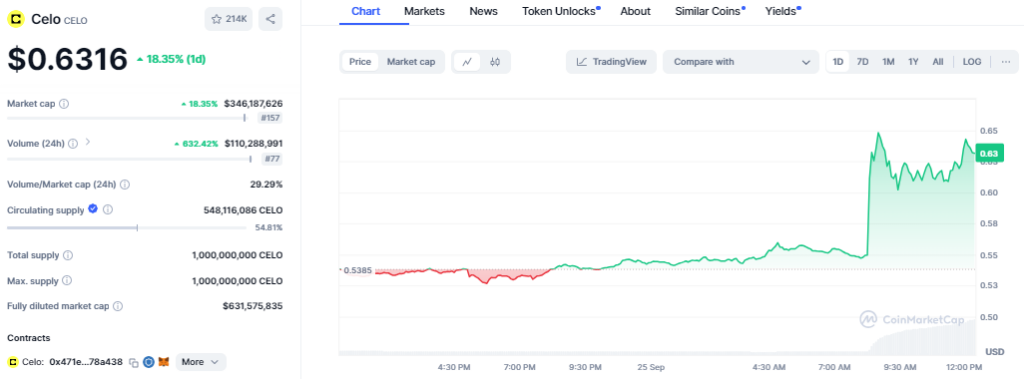Highlights:
- Vitalik Buterin applauds Celo for its peak stablecoin traffic and low transaction costs, boosting CELO token price.
- Celo is considering shifting to an EVM-compatible Layer 2 network, aligning closer with Ethereum’s ecosystem.
- Apps like MiniPay and Valora drive user growth, expanding Celo’s presence in African crypto markets.
Vitalik Buterin applauds Celo for its peak stablecoin traffic and accessible payment tools. His endorsement comes after Celo reached new heights in stablecoin transactions. CELO, the network’s native token, rallied to $0.63 following his remarks. Buterin, Ethereum’s founder, praised Celo in a recent post on X. He highlighted Celo’s low transaction costs and its role in decentralized financial services.
Buterin wrote:
“This is amazing to see. Improving worldwide access to basic payments/finance has always been a key way that Ethereum can be good for the world, and it’s great to see Celo getting traction.”
Celo Aligns with Ethereum’s Goals
Buterin’s support for Celo arrives after he outlined plans to endorse only sufficiently decentralized chains from 2025 onward. He considers Celo aligned with Ethereum’s aims of decentralization and accessibility. The network is exploring a migration to become an EVM-compatible Layer 2, similar to Optimism and Arbitrum.
This is amazing to see. Improving worldwide access to basic payments/finance has always been a key way that ethereum can be good for the world, and it's great to see @Celo getting traction.
See also their recent posts:
* @Celo becoming an Ethereum L2: https://t.co/08U7G7q69s
*… https://t.co/Qq7vcmZ6e3— vitalik.eth (@VitalikButerin) September 25, 2024
Celo develops the Valora app, which links user identity with on-chain actions. This lightweight wallet enables sending funds as easily as sending a chat message. With near-zero fees, Valora has driven stablecoin payments on Celo since 2021. Recently, apps like MiniPay have also contributed to significant user growth.
Surge in Stablecoin Activity
Celo’s network has seen a substantial increase in stablecoin traffic. It now carries over $1.12 billion in monthly stablecoin transactions. In the past three months, the stablecoin supply on the network rose by nearly 75%, leading to peak volumes. The network handles more than 292 million USDT stablecoins, with over 68 million transfers in that period.
This surge may be due to various factors, including decentralized finance and decentralized exchange trading. Celo surpassed TRON DAO in daily active addresses for stablecoin usage. The network saw close to 700,000 daily active addresses, boosted by stablecoin activity.
@Celo recently passed @trondao in daily active addresses for stablecoin usage.
-What's behind this meteoric rise?
-Is Africa undergoing a stablecoin breakout?A 🧵 pic.twitter.com/6Xn8CF6DfO
— Artemis (@artemis__xyz) September 16, 2024
Expansion in Africa and Token Rally
Apps like MiniPay and Valora have added significant users. MiniPay reached 1 million wallets within five months of launching in 2023. By July 2024, it had over 3 million activated wallets. After launching in Nigeria, MiniPay expanded to Kenya, Ghana, and South Africa. According to Chainalysis data, Nigeria ranks second in crypto adoption.
Following Buterin’s endorsement, CELO tokens experienced a price rally. As trading volumes increased, the market price rose from $0.55 to $0.63, surging by 18%. Despite this uptick, CELO remains in a narrow trading range and has yet to recover from the 2022 bear market.

Celo was among the high-profile projects of 2020, raising over $100 million with backing from Coinbase Ventures and a16z. The network aims for high-speed transactions while carrying a native form of Tether (USDT). It offers gas payments using stablecoins, eliminating the need to buy ETH or CELO.
Buterin has previously endorsed DeFi and Ethereum-compatible projects to spread financial services to the unbanked. He supports projects that align with Ethereum’s principles of decentralization. Celo’s approach to accessible financial tools resonates with these ideals.
Recently, Ethereum co-founder Vitalik Buterin shared his vision on the Bankless podcast. He plans to enable Ethereum nodes on mobile devices, making blockchain more accessible. Consequently, this move aims to lower barriers to entry and enhance decentralization. Moreover, it seeks to keep Ethereum competitive in the smart contract space.





